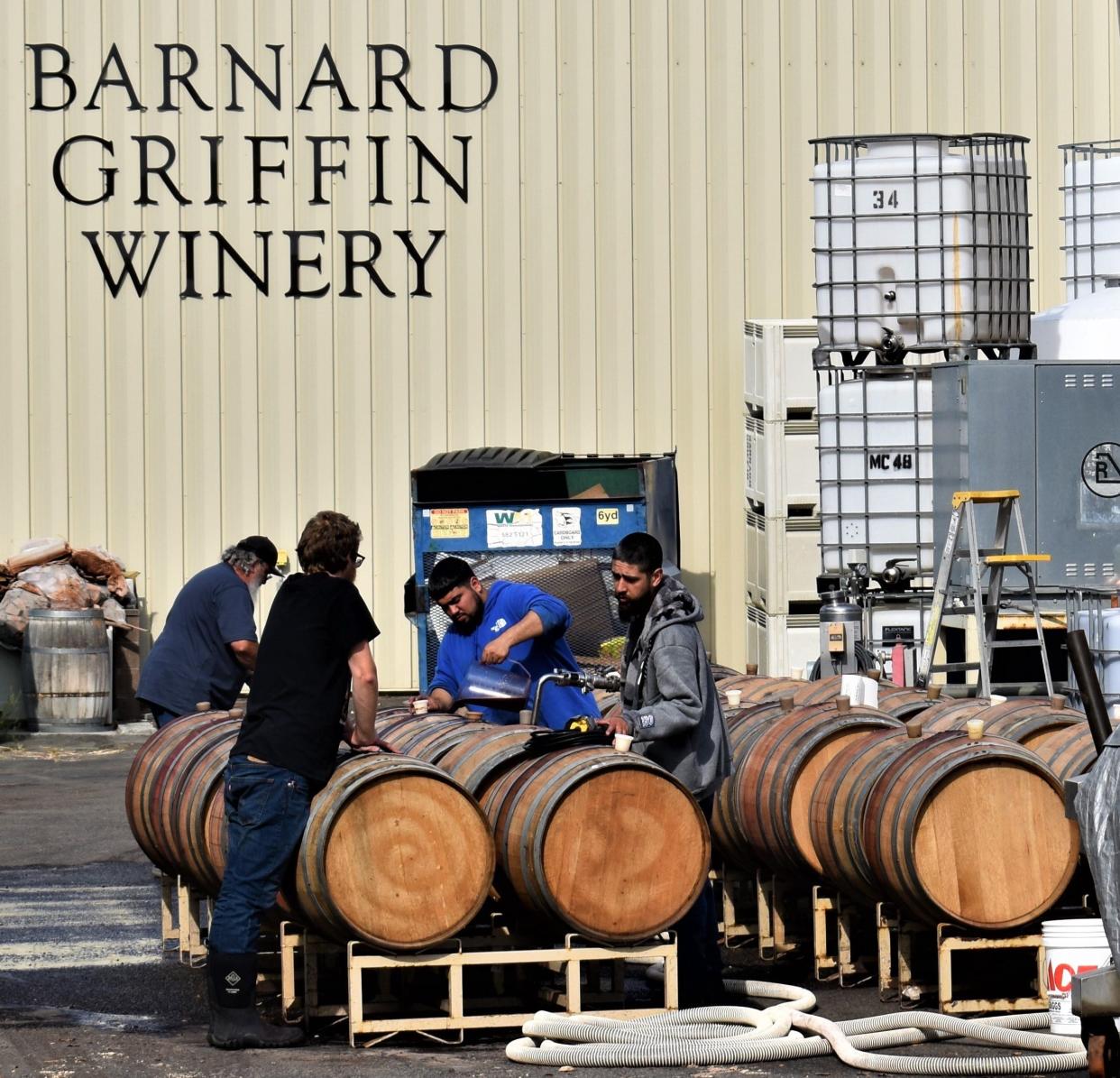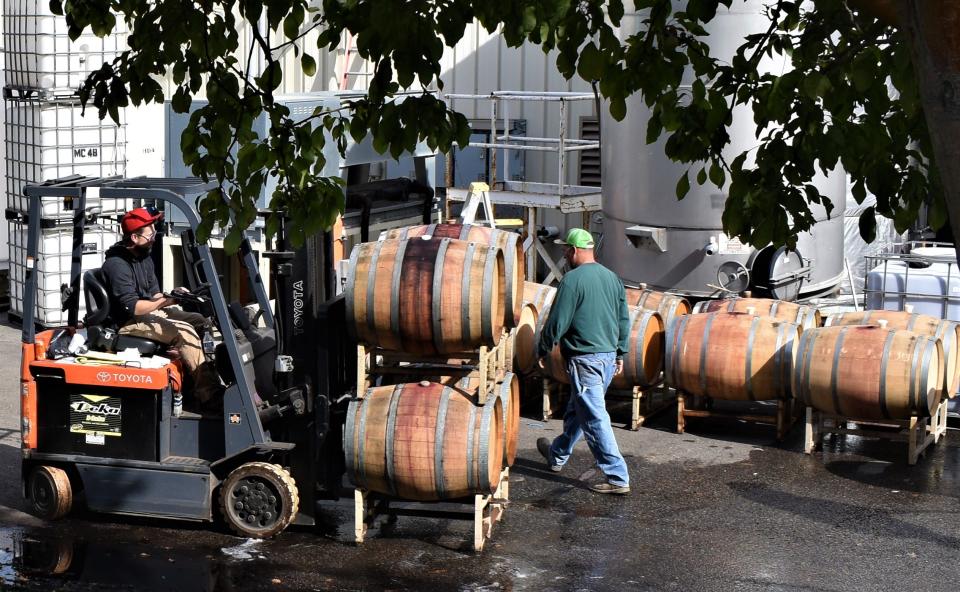Washington state's wineries manage a late harvest

This year’s wine grape harvest arrived later than “usual,” according to the executive director of the Washington Wine Growers Association, Vicky Sharlau. The culprit was a wet and chilly spring that set not only the grape harvest back about two weeks, but the cherry and apple harvests were also delayed.
I heard and saw this in my wine travels late last month; grapes covered in netting were still on the vine and winemakers were bringing in some reds before whites in some areas. The cool weather delayed grape maturation.
How winemakers determine when to harvest
Deciding when grapes have matured enough is a science with a bit of math thrown in. The decision of when to harvest depends on the level of sugars and acidity. There are other factors involved but the two most important ones are sugar and acid.
As grapes approach maturity, sugar levels increase and acid levels decrease. During harvest season, these levels are tested daily. Where these levels land will determine when to pick and the style of wine the winemaker hopes to achieve. But Mother Nature still has the final say in the matter.
During fermentation, the yeast gorges on fruit sugars, converting them into alcohol. Brix is a measurement that tells the percentage of sugar in the crushed grapes. It gives the winemaker an idea of the potential alcohol. Potential alcohol of the final product is calculated by dividing Brix in half and adding one and a half percentage points. So, grapes harvested at 24 Brix would likely produce a wine around 13.5% alcohol (24/2 = 12 + 1.5 = 13.5%).
The other key ingredient is potential of Hydrogen (pH), a measure of hydrogen ion activity or acidity within a solution. With a pH of 7, water is neutral. But grape juice has a fairly low pH (3.0 – 3.5) which means it’s acidic.
Because it is fermented twice – once to make the alcohol and once to make the bubbles, sparkling wine is usually picked around 20 Brix (low sugar) and 3.10 pH (high acidity). White wine would be harvested between 23-25 Brix and about 3.3pH. Red wines generally are 23 to 26 Brix and 3.4pH. The rare and elusive ice wines have had Brix readings upwards of 40 Brix, which balances the naturally higher acidity.
Grapes for bubblies are almost always harvested earlier than still whites or reds. And depending on Mother Nature, harvest for still wines could last well into fall. For ice wines, a freeze is necessary.
Mother Nature always has the last say in when to harvest. This year some wineries harvested reds before their whites! As if the schedule isn’t already crazy enough, this could turn out to be the longest harvest season in quite a while – mid-August through October.
Imagine, managing picking dates, harvesting either by hand or mechanically, putting the grapes into lugs or gondolas for transport, trucking grapes to the winery, sorting by hand, picking out leaves, rotten and unripe berries, destemming, forklifts tipping lugs of grapes into the crusher, hoses transferring the liquid from there to the fermenter, and managing fermentations.
From the fermenter, the liquid goes into tanks or barrels for aging. Forklifts move the barrels into the barrel room. And then performing that same process for the next variety and the next and the next. This time of year, wineries are a beehive of activity.
At the family-run Barnard Griffen Winery in Richland, owner/winemaker Rob Griffen has been making great wine in Washington state for 46 years. Some might dub him the dean of Washington wine and wine regions.
He began his illustrious career at UC Davis, moved to Washington state to make wine at Preston Winery in the late 70s, was hired by Hogue Cellars as winemaker a few years later and opened Barnard Griffen in 1983 while still making wine at Hogue.
When I arrived at the winery on a sunny Sunday afternoon, they were closed. Dang! However, Elyse Jackson, daughter Griffin and Debbie Barnard, popped out and informed me that today was “members-only event.” She graciously handed me a “member for a day” card to use on another day. Suitably impressed, I returned the next day.

Barnard Griffin’s tasting list included eight wines — a sparkling, Albariño, Viognier, Roussanne, Grenache, Cotes du Rob, Reserve Cab and Reserve Syrah. For $15, you pick four to taste and the tasting fee is waived when you buy two bottles.
But as a “member for a day,” the tasting was complimentary. I chose the non-vintage Gorge sparkling, Crawford Vineyard Albariño, Lonesome Springs Grenache and Columbia Valley Reserve Cab (Red Heaven Vineyards on Red Mountain AVA and Sagemoor Vineyards in the White Bluffs AVA). All of these wines were so wonderful and highly recommended.
The Gorge NV Sparkling was Barnard Griffin’s newest experiment. Normally, any sparkling wine that is “méthode Champenoise” goes through secondary fermentation in the bottle. The yeast eats the sugars and turns into carbon dioxide since it’s trapped inside the bottle.
And normally, the dead yeast cells are disgorged (frozen and then expelled) after a year or so of riddling. But not this “Gorge” sparkling. The little round yellow yeast cells were still present at the bottom of the bottle. That was different and delicious.
I was doubly fortunate in that there were special wines left over from the member-only event. Score! My favorite Rosé of Sangiovese, Signature Syrah, 2016 Lonesome Four (Petite Verdot, Malbec, Cab Franc and Cab), and the 2017 Cotes du Rob, a southern Rhone-type blend of Grenache, Durif (Petite Sirah), Syrah, Mourvedre, Cinsault and Counoise. I can also highly recommend each and every one of these wines.
Luckily, I happened upon crush too! After the tasting, the Orange Muscat grapes came rolling in on a big truck loaded with three gondolas full of grapes. I was invited to watch, so I took pictures of some of the action to share with you. Enjoy these harvest memories with the wines of Barnard Griffin Winery.
Mary Earl has been educating Kitsap wine lovers for a couple of decades, is a longtime member of the West Sound Brew Club and can pair a beer or wine dinner in a flash. She volunteers for the Clear Creek Trail and is a longtime supporter of Silverdale.
This article originally appeared on Kitsap Sun: Washington state's wineries manage a late harvest

